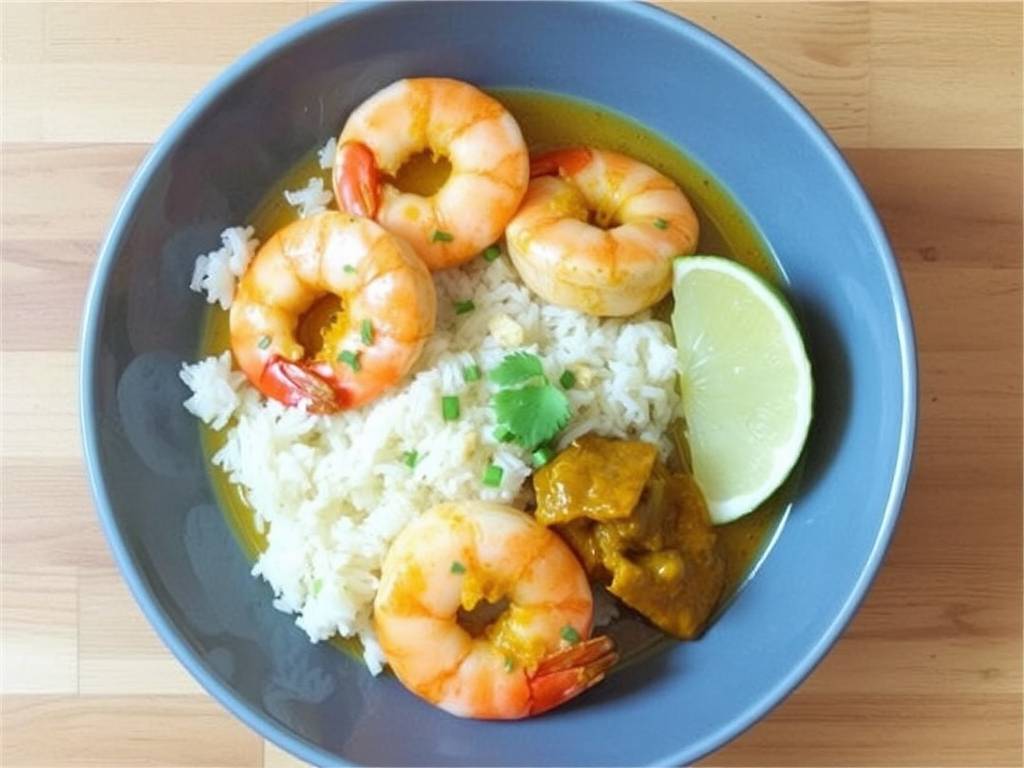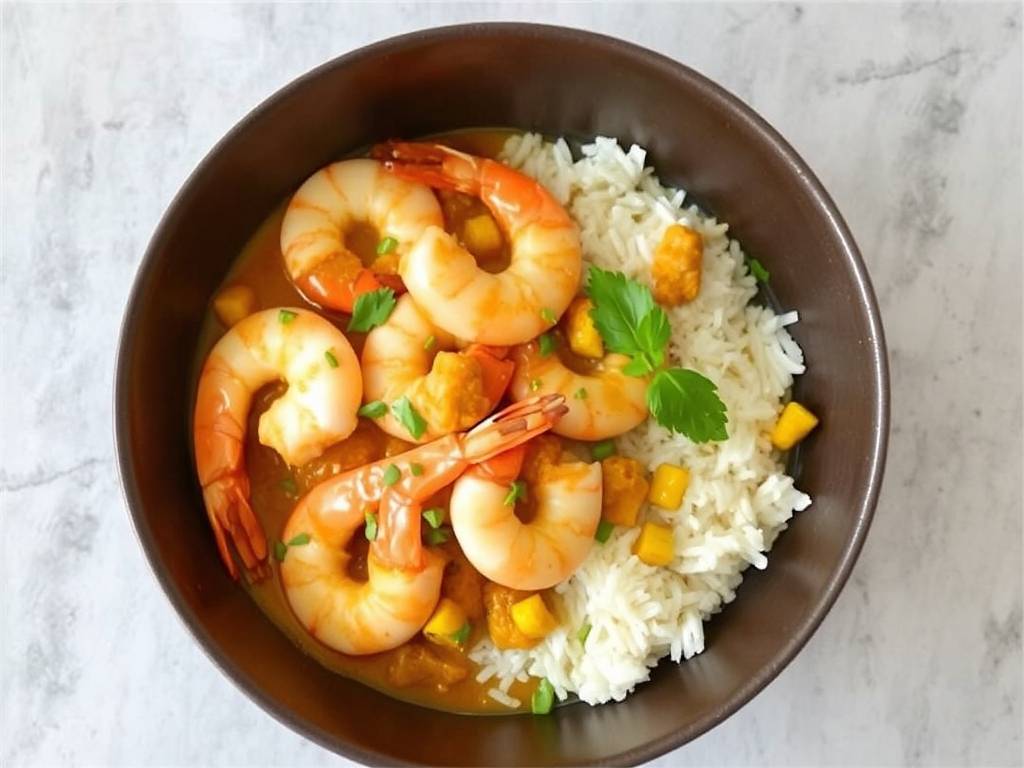A Culinary Journey to the Tropics: Mastering Prawns with Coconut Curry and Rice
There are few dishes in the world that so perfectly encapsulate the essence of comfort, vibrancy, and exotic flavour as a well-made Prawn Coconut Curry served over a bed of steaming rice. It is a symphony of taste, where the sweetness of fresh seafood, the rich creaminess of coconut, the fiery kick of spices, and the soothing neutrality of grain come together in harmonious balance. This dish, with its roots in the coastal regions of Southeast Asia, from Thailand to Sri Lanka and beyond, is not merely a meal; it is an experience, a warm embrace that transports you to sun-drenched shores with the first spoonful.
While it may seem like a complex restaurant specialty, the truth is far more encouraging. Creating an exceptional prawn and coconut curry at home is an achievable and deeply rewarding endeavour. It’s a process that invites you to engage your senses, to smell the aromatics as they sizzle, to taste and adjust as you go, and to create something truly magnificent from a handful of beautiful ingredients. This guide will walk you through each step, from selecting the finest prawns to building layers of flavour in your curry, ensuring your culinary journey is a resounding success.

The Foundation: Selecting and Preparing Your Ingredients
The soul of any great dish lies in the quality of its components. Taking care at this stage will pay dividends in the final result.
-
The Prawns: The star of the show deserves your attention. Opt for large, raw prawns (shrimp), preferably with the shells on. Why shells-on? The shells are packed with flavour that we can harness. Look for prawns that are firm, smell fresh and clean (not overly fishy), and have a translucent greyish colour. Frozen, raw, shell-on prawns are an excellent option and often more convenient; just ensure you thaw them slowly in the refrigerator overnight.
- Preparation: Peel and devein the prawns, but do not discard the shells! We will use them to create a quick, flavourful prawn stock that will elevate your curry to a new dimension. Simply simmer the shells in about two cups of water for 15-20 minutes, then strain. You now have a golden liquid that tastes profoundly of the sea.
-
The Aromatics and Spices: This is where the magic begins. You will need:

- Aromatic Base: Onion, garlic, and ginger (or galangal, if you can find it). Fresh is non-negotiable here. Finely chop or grate them to create a paste that will form the flavour foundation.
- Curry Paste: While making your own paste from scratch is a wonderful project (toasting coriander seeds, cumin seeds, dried chilies, etc.), a high-quality store-bought red or yellow curry paste is a fantastic shortcut. Look for brands with recognizable, natural ingredients.
- Fresh Flavours: Lemongrass is crucial. Bruise the stalk with the back of your knife to release its citrusy oils. Fresh lime leaves (kaffir lime leaves), if available, add an unmistakable floral-citrus note. Finally, a handful of fresh cilantro (coriander) for garnish.
-
The Coconut and Vegetables:
- Coconut Milk: Avoid the “light” versions for this recipe. You want full-fat coconut milk for its rich texture and flavour. Do not shake the can before opening. Spoon off the thick cream that has risen to the top—this will be the base for frying your curry paste.
- Vegetables: This is adaptable. Bell peppers (capsicum), sliced into strips, add sweetness and colour. Tender bamboo shoots or Thai eggplant are also classic additions.
-
The Rice: Jasmine rice is the traditional and perfect companion. Its delicate floral aroma and slightly sticky texture make it ideal for soaking up the curry. Basmati rice is another excellent choice for its long grains and fragrant quality. Rinse the rice thoroughly in cold water until the water runs clear to remove excess starch, which results in fluffier grains.
The Symphony of Cooking: A Step-by-Step Guide
Part 1: The Perfect Rice
A flawless curry deserves a perfect base. Cooking rice can be intimidating, but a simple method yields consistent results.
- Rinse: Measure your desired amount of jasmine rice (a good rule is ¾ cup of uncooked rice per person). Place it in a bowl and cover with cold water. Swirl it with your hand and drain. Repeat 3-4 times until the water is relatively clear.
- The Ratio: Use a 1:1.25 ratio of rice to water. For example, for 1 cup of rice, use 1 ¼ cups of water.
- Cook: Combine the rinsed rice and water in a saucepan with a tight-fitting lid. Bring it to a boil over high heat. As soon as it boils, immediately reduce the heat to the lowest possible setting, cover, and simmer for 15 minutes. Do not lift the lid. This traps the steam, which is essential for cooking the rice.
- Steam: After 15 minutes, turn off the heat and let the rice sit, covered, for another 10 minutes. This final steaming step ensures every grain is tender and separate. Fluff with a fork before serving.
Part 2: Building the Coconut Curry
This process is about building flavour in layers. Patience is key.
- Toasting the Paste: Heat a large wok or deep skillet over medium heat. Add the thick coconut cream scooped from the top of the can. Let it simmer gently for a few minutes until it “splits”—meaning the oils start to separate and you see little droplets of coconut oil shimmering on the surface. This is a critical step for depth of flavour.
- Frying the Aromatics: Add your curry paste to the fragrant coconut oil. Fry it for 2-3 minutes, stirring constantly, until it is incredibly aromatic and the raw smell has cooked off. Then, add your chopped onion, garlic, and ginger. Continue to cook for another 3-4 minutes until the onions have softened.
- Creating the Sauce: Pour in the remaining coconut milk, along with your homemade prawn stock (or water, if you didn’t make stock). Add the bruised lemongrass stalk and torn lime leaves. Bring the curry to a gentle simmer and let it cook for about 10 minutes, allowing the flavours of the lemongrass and lime leaves to infuse the liquid.
- Adding Vegetables and Prawns: Now, add your harder vegetables like bell peppers. Simmer for 2-3 minutes until they begin to soften. Then, add the raw prawns. They cook very quickly—in just 2-4 minutes, depending on their size. You will know they are done when they turn opaque and pink and curl into a loose “C” shape. Do not overcook the prawns, or they will become tough and rubbery.
- The Final Seasoning: Turn off the heat. This is the time to balance the flavours. Stir in a tablespoon or two of fish sauce for saltiness and umami. Add a squeeze of fresh lime juice—this brightens the entire dish, cutting through the richness. Taste. Does it need more salt? More lime? More heat? A pinch of sugar can help balance acidity if needed. Stir in a handful of fresh cilantro.
Serving and Savoring the Experience
Presentation is the final act. Spoon the fluffy jasmine rice into wide, shallow bowls. Ladle the vibrant, aromatic curry and prawns over and around the rice, ensuring plenty of sauce. Garnish with more fresh cilantro and a wedge of lime on the side.
Encourage your guests to mix the rice and curry together, scooping up a bit of everything in each bite. The combination of the tender, sweet prawns, the creamy, spicy coconut sauce, and the fragrant rice is nothing short of sublime. It’s a dish that invites conversation, satisfaction, and perhaps a second helping.
Variations and Personal Touches
The beauty of this recipe is its flexibility. Feel free to make it your own:
- Spice Level: Control the heat by adjusting the amount of curry paste or by adding fresh sliced bird's eye chilies at the same time as the aromatics.
- Protein: While prawns are classic, you can use scallops, firm white fish like cod, or even chicken thighs (which will require a longer cooking time).
- Vegetables: Get creative! Spinach or kale wilted in at the end, green beans, snap peas, or carrots would all be wonderful additions.
- Herbaceous Finish: Along with cilantro, Thai basil adds a wonderful anise-like flavour. Stir it in at the very end.
Cooking Prawns with Coconut Curry and Rice is more than following a recipe; it’s an invitation to explore a world of flavour from your own kitchen. It’s a testament to how a few simple, quality ingredients, treated with care and respect, can create a dining experience that rivals any tropical getaway. So, gather your ingredients, embrace the process, and prepare to delight in the incredible results.






发表评论